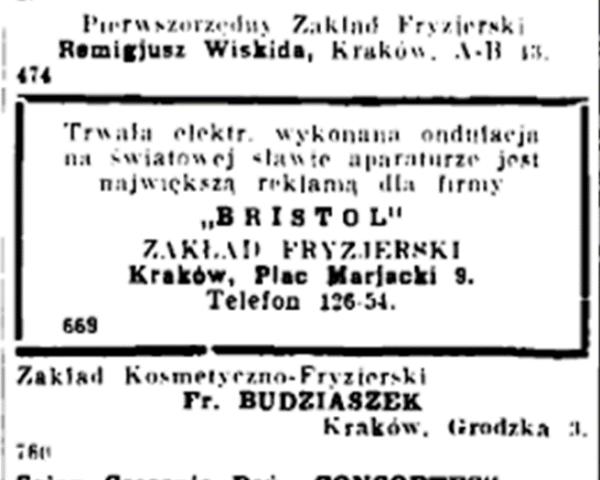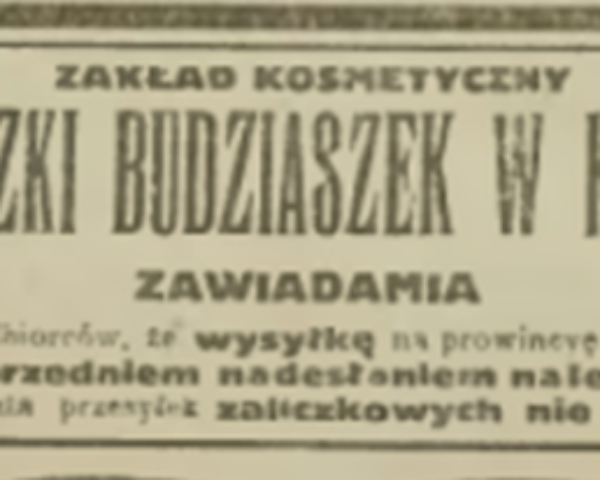Franciszka Budziaszek-Resich was a well-known hairdresser in Cracow whose hair salon enjoyed an excellent reputation...
Franciszka Budziaszek Resich
Franciszka Budziaszek-Resich was a well-known hairdresser in Cracow whose hair salon enjoyed an excellent reputation. It was going so well that she could afford to rent a salon in a very prestigious location. The last address of her salon was on the first floor of a tenement house at Grodzka Street 3, right next to the Market Square.
Franciszka is remembered as a beautiful woman with very long fair hair.
Besides her daily work, she also engaged in charity work and helping people in need. Even after the outbreak of WWII, she did not give up on it. Using her abilities and resources, Franciszka helped Jewish women to conceal their provenience. There was a common stereotype about what a Jewish woman looked like: dark, most often curly hair, dark eyes, quite dark skin. Thus, Franciszka helped Jewish women look more “Aryan” by dying their hair, eyebrows and eyelashes blonde, straightening their hair and offering treatments that made their skin look lighter. It is not known how many people she was able to help. Unfortunately, after some time Franciszka was denounced, arrested and deported to the Ravensbrück camp, where she died.
The famous Polish journalist Alicja Resich-Modlińska is Franciszka Budziaszek-Resich’s granddaughter.
-
Advertisement for the Franciszka Budziaszek salon
in the Address Book of the City of Krakow and the Krakow Province With M. St. Of Warsaw, Voiv. Kielecki and Śląskie. Born in 1933/34
-
Advertisement for Franciszka Budziaszek’s salon in the “Czas” magazine;
Time 1919, No.67 (March 14)
Classification
At this stage, society is divided into opposing groups: into “us” and “them,” e.g. Poles and Jews.
This process can be counteracted by emphasizing and nurturing what both groups have in common. It is worth focusing on common values, traditions, or experiences, as well as looking for areas of the agreement through the creation of support groups and initiatives to fight hatred.
How does this person’s story illustrate response to the particular stage of genocide in Dr. Stanton’s theory?
In the Third Reich, the Nazis conducted pseudoscientific research on human races. They wanted to find out what a “model” Jewish, Romani or Sinti person (or other “non-Aryan” person) would look like so that it would be easier to tell them apart from the “Aryans.” According to Nazi propaganda, Jews typically had dark eyes, dark and curly hair, crooked noses and an “insecure” way of moving around. These features were often referred to as the so-called “bad appearance, ” indicating that a person was Jewish. A “good appearance”, on the other hand, meant that a person did not have these features or was able to conceal them. The main features of a “good appearance” were blonde hair and eyebrows and fair skin. Such an appearance, along with forged documents, helped Jewish people hide outside the ghetto, on the so-called “Aryan side.”
Both the Nazis and people who collaborated with them by denouncing Jews paid close attention to a person’s appearance. When they classified someone as Jewish based on such clichéd physical features, this person was most often sent to a ghetto or a concentration camp or even killed straight away. Franciszka Budziaszek was helping Jewish women by concealing their “Jewish” features so they wouldn’t be classified as “racially inferior.”
People with disabilities the worlds largest minority
Magda Szarota, researcher in disability studies, human rights activist, Board Member of Humanity in Action Poland Foundation



